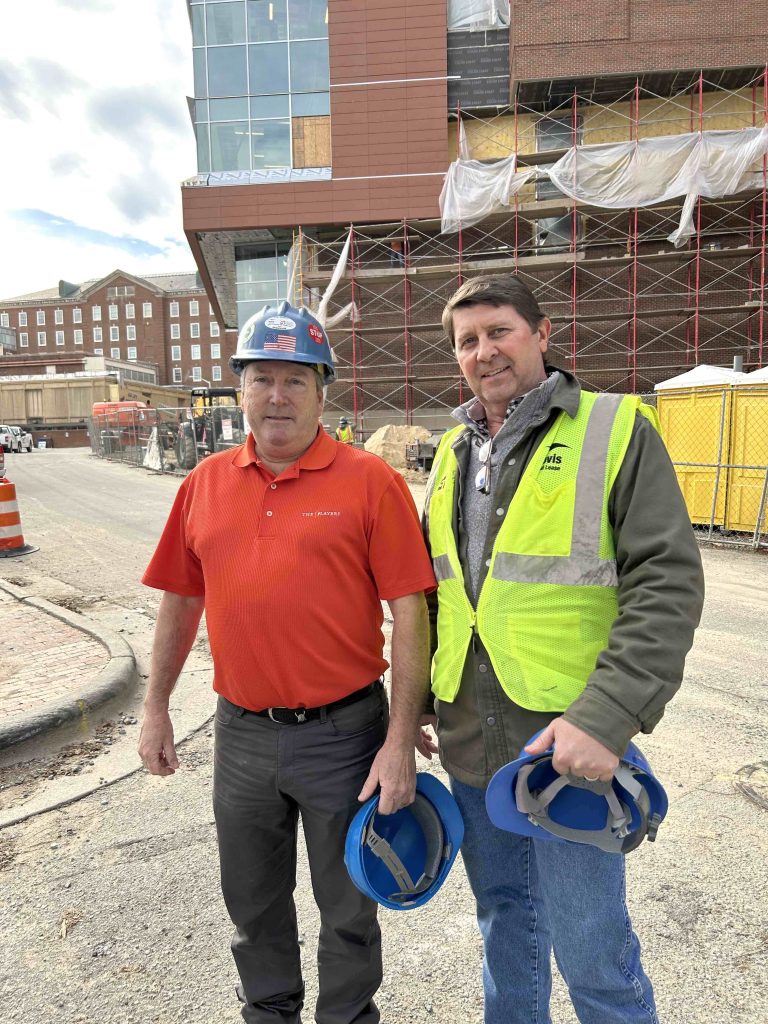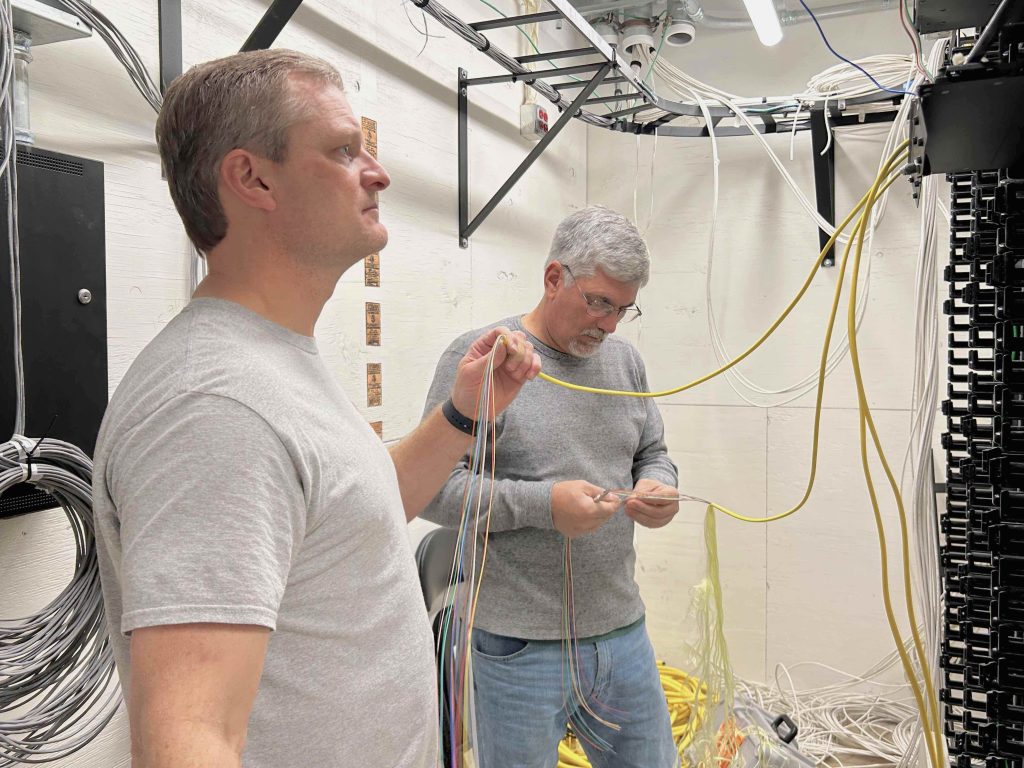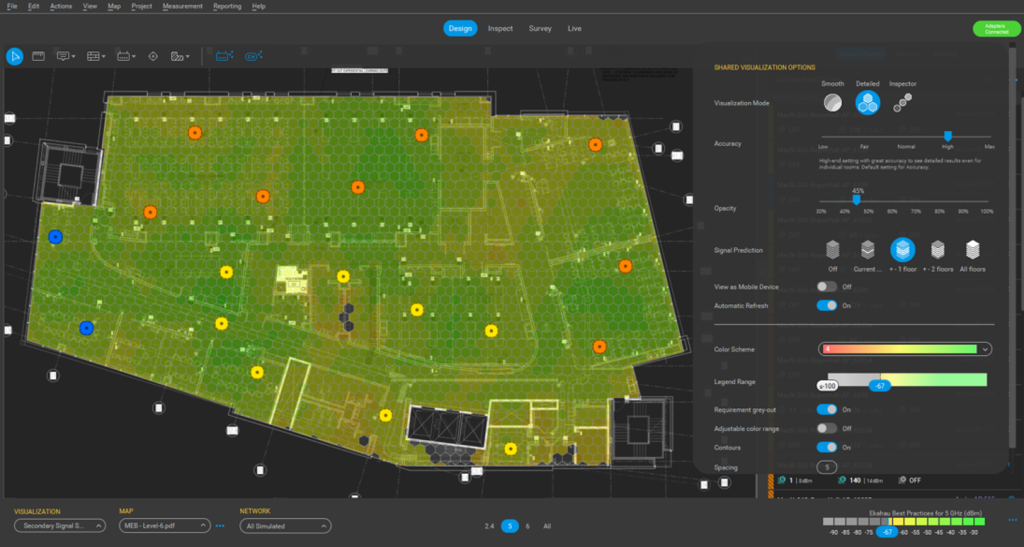
As hard hat-clad laborers bustle on each floor of the construction site on a January morning, ITS staff members lug fiber into and commence the labyrinthine task of wiring the building’s main telecommunications closet — one of eight telecom rooms for them to configure in the high-rise.
Members of the ITS Engineering team, meanwhile, maneuver through partially constructed hallways, rooms and stairwells, checking on the progress of network cable infrastructure and identifying installation issues that need attention. There’s a single faceplate on a double gang outlet box and a wiring sleeve is missing a grommet — minutiae among the nearly endless and vital construction specifications for which ITS Engineering is jointly responsible.
Vital role in Roper Hall project
The project these ITS professionals are contributing to is Roper Hall, the UNC School of Medicine’s new medical education building that is expected to open later this year. When it comes to campus construction, renovation and demolition projects, few University members realize that ITS plays a key role — from start to finish.
This 172,000-square-foot structure that will become Roper Hall is being built on the former site of Berryhill Hall. The five-decades-old Berryhill was demolished to provide space for this modern edifice where med school students will learn and develop into future healthcare providers. At Roper Hall, students will benefit from the latest technology for simulation and telemedicine and classroom spaces designed to facilitate collaboration. The building also will provide enhanced connections between med students in Chapel Hill and those learning at satellite campuses.
Assisting since the design phase
ITS Engineering staffers began working on this colossal project in 2019 by reviewing designs and participating in design meetings. ITS’ role in this building project will wrap up only after everyone moves in and billing is completed, explains ITS Engineering’s Franklin Hall, as he provides a tour. He has participated in this project since the first design meeting. Like on this January day, Hall visits the construction site weekly. Accompanying Hall on this morning is Chuck Reese. It’s his first day on the job with ITS Engineering and his first day at the construction site.

During this site tour, as easily as the rest of us would recollect our street address, Hall reels off a particular project spec that he notes is contained within revision No. 41. He can recite each project revision and what each encompasses.
Multiple ITS teams contribute
One stop along the Roper Hall construction tour is the main telecommunications closet. Two hours earlier, Kevin Wicker and Danny Maddox of ITS Transport Operations began pulling fiber into the small telecom room. On this day, their hands swiftly and expertly toil through and connect the masses of cables, working toward their deadline of connecting the building to the University’s data network. On any construction project, whenever the ITS Transport Operations team brings in fiber, which is such an important project milestone, Hall says it’s “such a relief to me; they make the project.”
Another ITS unit contributing to this construction project is ITS Network Deployment (Net Deployment). Those team members work in conjunction with the Med School OIS Network group to install the data network switches and activate data ports, configuring them to the correct virtual local area network (VLAN) within the overall data network. Once the network is live, the primary operation of the network will then be assumed by School of Medicine IT, with Net Deployment in an ongoing support role.

ITS’ Wireless Engineering group, meanwhile, used sophisticated modeling software to design a Wi-Fi system that efficiently provides service to the entire building. ITS’ lead wireless engineer for the project, Dawn Douglass, explains that the Roper design includes 140 different wireless access points (radio devices) strategically placed on each floor. Network Deployment will install those devices and tune and commission the system.
Coordination is key
For ITS groups contributing to Roper Hall and other campus capital projects, coordination is the name of the game.
“Our general role in Engineering is to reconcile the University’s objectives for networking and telecommunications with the physical realities of building and campus conditions — coordinating the needs of technology systems with the activity of the construction industry,” says ITS Engineering’s Dan Pellegrino, who has worked closely with teammate Hall on Roper and multiple other campus construction projects.
Pellegrino, Hall, and now Reese each possess a vast knowledge of all things construction related. They speak contractors’ language and understand their daily routines and challenges. They keenly grasp adhering to legal contracts and monitoring compliance.
Supporting construction across campus
Members of the ITS Engineering team and other ITS teams who work on these construction projects think of themselves as a larger team providing support to other groups and facilities services in other schools and departments.
These ITS teams, in fact, have a myriad of projects that will keep them working with and supporting internal campus entities and those external in the construction industry. In addition to Roper Hall, ITS is helping with the planned new building for Kenan-Flagler Business School, the development of the Cone-Kenfield Tennis Center for UNC Athletics and the creation of an innovation hub within a building on East Rosemary Street.
